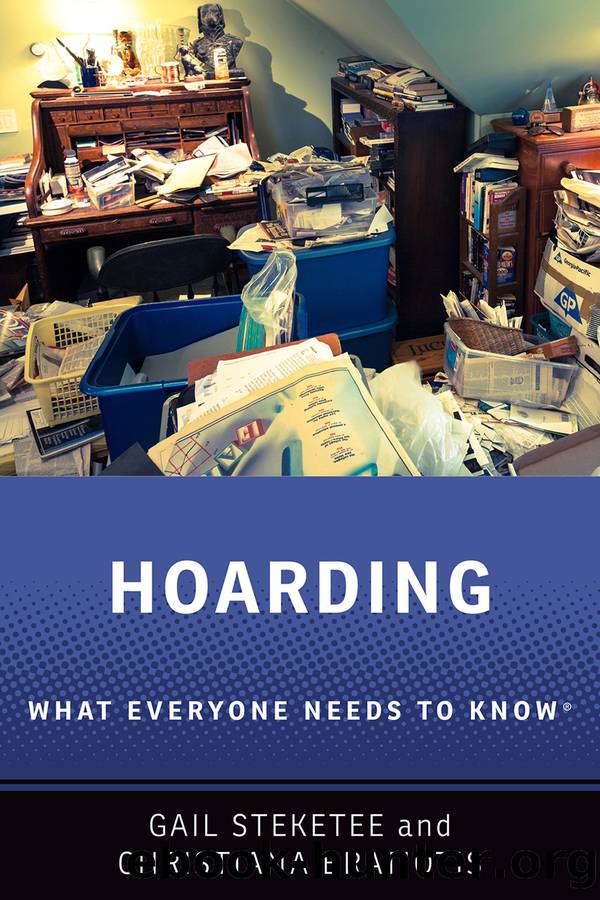Hoarding by Gail Steketee

Author:Gail Steketee
Language: eng
Format: epub
Publisher: Oxford University Press
Published: 2020-10-15T00:00:00+00:00
What other assessments can help determine the severity of hoarding?
In this chapter weâve directed the reader to the most commonly used methods of measuring the severity of hoarding and assessing related features. These include self-report and clinician-administered tests that are applicable to research and practice contexts for clinical and community providers. We conclude by drawing attention to a few additional assessment instruments relevant to hoarding and squalor in case these are useful to readers in the course of their work on hoarding. These measures can be found through an online search. The first two are diagnostic instruments intended to determine the presence of HD.
⢠Structured Interview for Hoarding Disorder (SIHD) is based on the criteria for HD in the fifth edition of the American Psychiatric Associationâs Diagnostic and Statistical Manual of Mental Disorders (DSM-5). It contains questions about clutter, difficulty discarding, acquisition, distress, and interference and inquires about co-occurring mental and medical conditions in order to make a differential diagnosis. It is intended for use by trained clinicians and can be found through an internet search.
⢠Diagnostic Interview for Anxiety, Mood, and OCD and Related Neuropsychiatric Disorders (DIAMOND) is a promising semistructured diagnostic interview for DSM-5 disorders that includes a specific segment to identify HD and make a differential diagnosis.
⢠UCLA Hoarding Severity Scale (UHSS) is a 10-item semistructured interview that contains questions similar to the HRS described above and also includes assessment of indecisiveness, procrastination, perfectionism, and task completion rate. It is designed for use by mental health clinicians and can be found through an internet search.
⢠Compulsive Acquisition Scale (CAS) is an 18-item assessment to determine the presence of excessive acquisition. The measure has two subscales: compulsive buying (12 items about the reasons for buying and interference caused) and acquisition of free things (6 items about picking up free things). The CAS can be used in clinical and community settings and is especially relevant for those with serious acquiring problems.
⢠Environmental Cleanliness and Clutter Scale was developed by Dr. John Snowden and colleagues to measure aspects of domestic squalor such as accumulation of items, cleanliness, and the presence of vermin. Individual items of this scale were also shown to be closely related. A score greater than 12 usually indicates moderate or severe squalor. It is available at projects.hsl.wisc.edu.
Download
This site does not store any files on its server. We only index and link to content provided by other sites. Please contact the content providers to delete copyright contents if any and email us, we'll remove relevant links or contents immediately.
| Administration & Medicine Economics | Allied Health Professions |
| Basic Sciences | Dentistry |
| History | Medical Informatics |
| Medicine | Nursing |
| Pharmacology | Psychology |
| Research | Veterinary Medicine |
Periodization Training for Sports by Tudor Bompa(8103)
Why We Sleep: Unlocking the Power of Sleep and Dreams by Matthew Walker(6566)
Paper Towns by Green John(5031)
The Immortal Life of Henrietta Lacks by Rebecca Skloot(4456)
The Sports Rules Book by Human Kinetics(4223)
Dynamic Alignment Through Imagery by Eric Franklin(4055)
ACSM's Complete Guide to Fitness & Health by ACSM(3943)
Kaplan MCAT Organic Chemistry Review: Created for MCAT 2015 (Kaplan Test Prep) by Kaplan(3913)
Introduction to Kinesiology by Shirl J. Hoffman(3700)
Livewired by David Eagleman(3628)
The River of Consciousness by Oliver Sacks(3505)
The Death of the Heart by Elizabeth Bowen(3492)
Alchemy and Alchemists by C. J. S. Thompson(3426)
Bad Pharma by Ben Goldacre(3217)
Descartes' Error by Antonio Damasio(3195)
The Emperor of All Maladies: A Biography of Cancer by Siddhartha Mukherjee(3028)
The Gene: An Intimate History by Siddhartha Mukherjee(3016)
The Fate of Rome: Climate, Disease, and the End of an Empire (The Princeton History of the Ancient World) by Kyle Harper(2978)
Kaplan MCAT Behavioral Sciences Review: Created for MCAT 2015 (Kaplan Test Prep) by Kaplan(2910)
